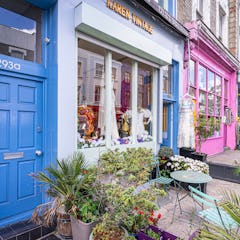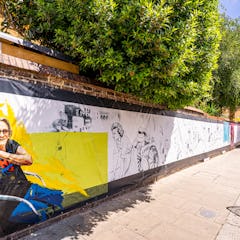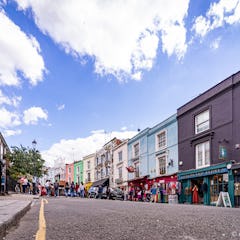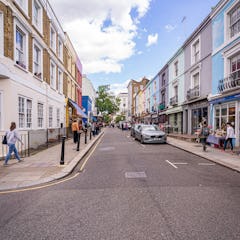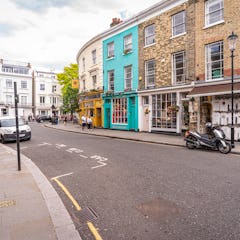Notting Hill is a postcard-perfect neighbourhood that surprises
Notting Hill in London is a popular tourist destination known for its pastel-coloured houses, the Portobello Road markets, and its famous carnival. It is also known for filming locations associated with movies and offers a wide variety of sights, restaurants, cafés, and cultural events.
History – From Monastery Farmland to Cultural Centre
The name Notting Hill traces its roots back to the medieval “Notting Barns” farm, which is mentioned in documents as early as the 14th century. “Notting” may refer to a person’s name or an ancient place name, while “Hill” describes the area’s gently rolling terrain. For a long time, the area was countryside and farmland, serving as part of London’s expanding outer fringe. In the early 19th century, as London industrialised and its population grew, more housing was needed, and the area began to develop into a residential district.
The Ladbroke family purchased the land in the early 1800s and, under the guidance of architect Thomas Allason, planned to develop it into an upscale neighbourhood.
After World War II, many immigrants from the Caribbean moved into the area, bringing multicultural influences to Notting Hill. This transformation introduced distinctive features, including Caribbean music, food culture, and festivals. The Notting Hill Carnival emerged from these roots and is now London’s largest street festival.
In the 1970s and 1980s, the area became even more popular. Its bohemian atmosphere and the arrival of creative professionals made Notting Hill one of London’s most desirable residential districts. Today, it remains one of the city’s culturally most affluent and most expensive neighbourhoods.
Architecture and Urban Development
Notting Hill’s architecture is one of its most iconic features. Most buildings date back to the mid-19th century and are typically Victorian or Georgian townhouses, adorned with decorative balconies, tall windows, and pastel-coloured façades. The rows of houses on Elgin Crescent and Lancaster Road are especially famous for their picturesque appearance, reflecting the area’s architectural heritage and the style of the era.
Urban development in Notting Hill began in the early 1800s, when the Ladbroke family and architect Thomas Allason transformed the area into a residential district. Allason’s 1823 plan featured oval squares, garden squares, and curved streets, departing from the more rigid layouts common at the time.
Portobello Road – Markets, Antiques, and Local Vibe
Portobello Road is the heart of Notting Hill. This winding street comes alive on weekends with market stalls selling a diverse range of items, from antiques and vintage fashion to street art and food. The Saturday antique market draws visitors from around the world, but even on weekdays, the street bustles with small cafés, independent shops, and popular local eateries. Over time, the markets have evolved from local open-air stalls into a global attraction.
Notting Hill Carnival – Europe’s Largest Street Festival
The Notting Hill Carnival is Europe’s largest street festival and one of London’s most famous cultural events. Celebrating Caribbean culture, the carnival is filled with music, colourful costumes, dance, food stalls, and parades. The event began in 1966, organised by journalist and activist Claudia Jones. Over the decades, the carnival has grown into a celebration that attracts over a million people.
Cinemas and Movie Footprints – Notting Hill on the Big Screen
A highlight of Notting Hill’s cinema offerings is the Electric Cinema, one of the world’s oldest working cinemas. Initially opened in 1910, it sits directly on Portobello Road, offering a unique viewing experience. The theatre features spacious leather armchairs with footrests and soft blankets. In the front row, there are even love seats, allowing viewers to enjoy films in comfort. The ambience of the Electric Cinema transports you back in time. Its programming is carefully curated, combining major new releases, independent films, and documentaries.
Notting Hill gained international fame due to the 1999 film of the same name. Starring Hugh Grant and Julia Roberts, the movie immortalised the blue door, the Portobello Road markets, and the neighbourhood’s romantic atmosphere. Although some of the film’s locations have changed, many are still recognisable. The blue door of Hugh Grant’s character’s home stands at 280 Westbourne Park Road, but it is not the original; the original was auctioned off due to the film’s popularity, and a new door now stands in its place. The bookstore featured in the movie was located at 142 Portobello Road, and today a gift shop with a nearly identical name occupies that site.
St Luke’s Mews – A Small, Picturesque Lane
St Luke’s Mews is one of Notting Hill’s most idyllic and charming streets. This picturesque lane became famous through the film Love Actually, in which Mark (Andrew Lincoln) rings Juliet’s (Keira Knightley) doorbell and confesses his feelings.
Museum of Brands – A Journey Through Consumer History
The Museum of Brands is situated in Notting Hill and offers visitors a journey through British consumer history. At its heart is the “Time Tunnel,” which showcases the evolution of product packaging, advertising, and design from the Victorian era to the present day. The museum offers a fascinating insight into how consumption and branding have shaped society.
Hotels – Charming Accommodation by Parks and Lanes
Notting Hill’s hotel offerings are not dominated by large chains like in many other places. Instead, you’ll find mostly stylish boutique hotels and guesthouses that blend harmoniously with the area’s architecture. The Laslett, located just a stone’s throw from Notting Hill Gate station, combines modern décor with local art in a cosy atmosphere. The Portobello Hotel is also renowned for its charming rooms and tranquil location, situated beside a historic garden. Most accommodations are within walking distance of the markets and cafés.
Practical Tips for Visitors
Notting Hill is easily accessible by tube. The area has several stations, including Notting Hill Gate, Ladbroke Grove, and Westbourne Park. On Saturdays, when the Portobello market is in full swing, the street can become very crowded, so arriving in the morning ensures a calmer experience. The area is particularly photogenic in the soft morning light, and many photographers head there before the busiest tourist times. Notting Hill is best explored on foot, and comfortable shoes are a must. If you want to avoid crowds, weekdays are the best time to experience the neighbourhood’s character and browse its shops.
Summary – Notting Hill: History, Culture, and Picturesque Charm
Notting Hill is more than just pastel houses or festival vibes. It is a neighbourhood where history, culture, and everyday aesthetics converge. The Portobello Road markets, Electric Cinema, and Notting Hill Carnival are just a few examples of the area’s diverse attractions. Visitors are drawn to Notting Hill’s unique atmosphere, where antique shops, artisan boutiques, cafés like Farm Girl, and galleries such as Graffik Gallery make it a fascinating destination. A visit can be as much about vintage shopping or enjoying a flat white in a sunny courtyard as it is about standing on a street corner listening to steel-pan rhythms. Film lovers can visit the famous blue door or browse the Notting Hill Bookshop, both of which evoke the spirit of the movie.
